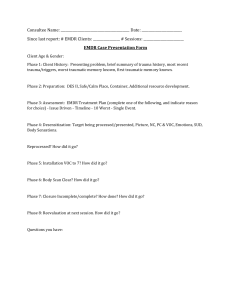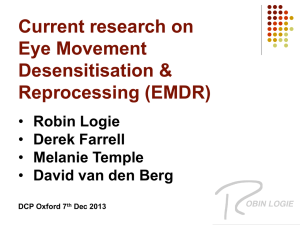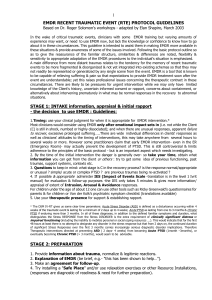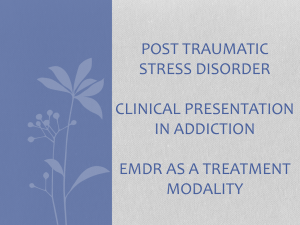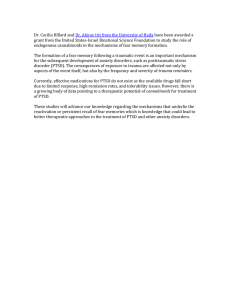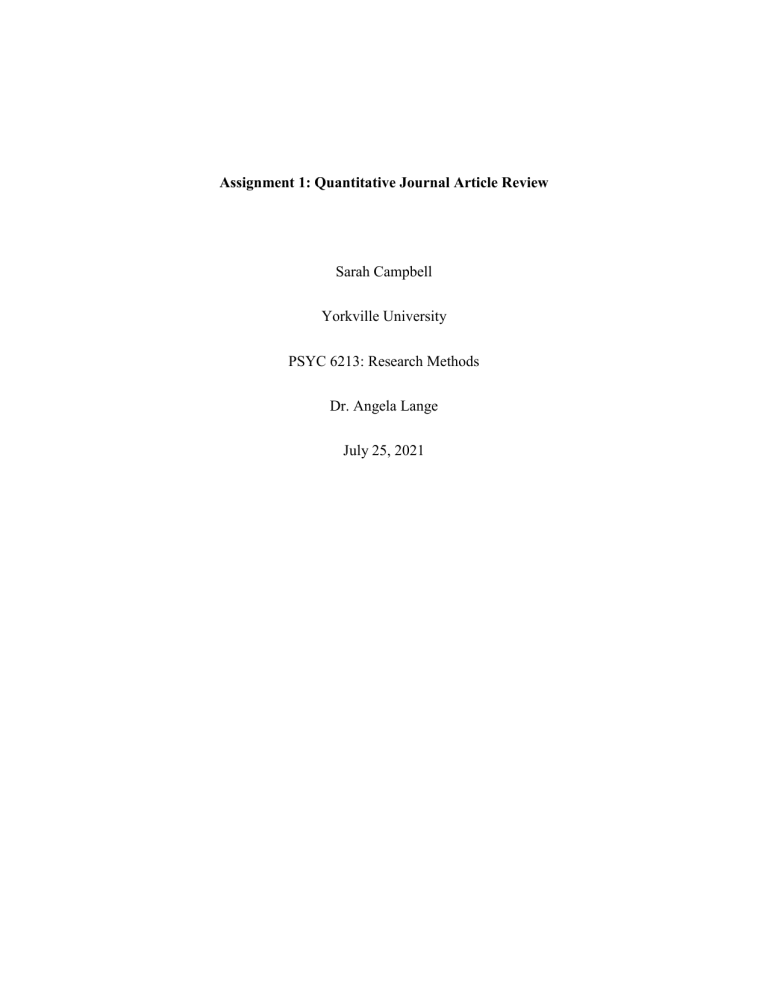
Assignment 1: Quantitative Journal Article Review Sarah Campbell Yorkville University PSYC 6213: Research Methods Dr. Angela Lange July 25, 2021 i Abstract This assignment is comprised of a Journal Article Review (JAR) related to the topic chosen for the Final Project: Eye Movement Desensitization and Reprocessing Therapy (EMDR) for treating posttraumatic stress disorder (PTSD) symptoms in children. This article, EMDR for children with medically related subthreshold PTSD: short-term effects on PTSD, blood-injection-injury phobia, depression and sleep employs an experimental research design and is relevant to the topic of the Final Project because it conducts the first randomized controlled trial investigating EMDR therapy for children who have PTSD symptoms after experiencing medically related trauma. 1 Meentken, M., Mheen, M., Beynum, I., Aendekerk, E., Legerstee, J., Ende, J., Del Canho, R., Lindauer, R., Hillegers, M., Moll, H., Helbing, W., Utens, E. (2020). EMDR for children with medically related subthreshold PTSD: short-term effects on PTSD, blood-injectioninjury phobia, depression and sleep. European Journal of Psychotraumatology, 11 (1). Statement of Problem Researchers are addressing how to reduce subthreshold PTSD symptoms in children experiencing medically related trauma using EMDR therapy. The research question is how effective EMDR is in treating children experiencing subthreshold PTSD symptoms due to medically related trauma. Literature Review Previous studies have shown posttraumatic stress reactions and other psychopathological symptoms in children and adolescents after experiencing hospitalization and medical procedures (Kahana et al., 2006) and (Price et al., 2015). Studies have displayed common symptoms after medical treatment can include posttraumatic stress, anxiety, blood-injection phobia, mood, and sleep problems (Lewandowski et al., 2011) and (Pinquart & Shen, 2011). EMDR has been highly studied for treating PTSD in adults, (Bisson et al., 2013) and (Chen et al., 2014) although there is a shortage of studies researching EMDR effectiveness for children (Herschell et al., 2004). Hypotheses To Be Tested The researchers hypothesized that EMDR therapy may be effective in reducing subthreshold PTSD symptoms after hospitalization for pediatric illness or injury. Method A randomized control trial (RTC) was executed using a single-centre study at the Erasmus MC Sophia children’s hospital in Rotterdam, the Netherlands. 2 Participants The participants consisted of 420 children aged 4-15 with medically related subthreshold PTSD symptoms after minimum one hospitalization and one overnight. Participants were recruited from Erasmus MC Sophia Children’s Hospital, the Dutch Association, the Dutch nonprofit organization Stichting Hartekind, Maasstad Ziekenhuis Rotterdam and the Radboud UMC (Meentken et al., 2018). Flyers about the study were distributed in the waiting areas of participating departments and all eligible patients received information letters inviting them to participate in the study (Meentken et al., 2018). Materials To measure primary outcomes of PTSD symptoms, participants were screened for having at least two of the three DSM-IV PTSD symptom criteria using the Dutch version of the Children's Responses to Trauma Inventory (CRTI). The CRTI consists of 24 PTSD items divided into three subscales related to the DSM-IV-TR symptoms clusters of PTSD (intrusion, avoidance, and hyperarousal). The original CRTI has shown moderate to excellent reliability and both convergent and discriminant validity in past studies, but it also had limitations in scope of the items and formulation (Alisic et al., 2010). Procedure Once informed consent was obtained, children were screened for subthreshold PTSD symptoms using the CRTI. Questionnaires were completed online by parents, children (6–15 years) and teachers except one questionnaire that was filled out on paper (Meentken et al., 2018). The remaining 74 participants were separated into two groups through randomization on a 1:1 ratio, one group received EMDR therapy, and the second group received routine care as usual 3 (CAU). An independent researcher oversaw randomization and used opaque envelopes to conceal from the main researcher enrolling and assessing participants to avoid selection bias. Statistics The primary statistical design employed was a true experimental design. Data was analyzed using the CRTI. The effectiveness of EMDR treating PTSD symptoms in this study is measured by the difference in CRTI-PTSD total score at T2 between the EMDR and CAU group (Meentken et al., 2018). Inferential statistical analysis used were t-tests and χ2-tests to test the differences between the EMDR and CAU groups at baseline. Correlations between child and parent reports were analyzed using Pearson’s r and differences were tested using paired sample ttest. Generalized Estimating Equations (GEE) was used with an unstructured correlation matrix to test for differences in outcome scores between the EMDR group and CAU group. Results Primary outcomes for children in both EMDR and CAU groups, showed similar reduction in their PTSD symptoms from baseline to follow-up assessments. EMDR was not significantly superior when compared to CAU in reducing child-reported (b = −0.5, p =.853) and parent-reported (b = −3.5, p =.275) subthreshold PTSD symptoms of the child. Secondary outcomes found child-reported symptoms of blood-injection-injury phobia decreased significantly more in the EMDR group than in the CAU group (b = −1.5, p =.034). Secondary outcomes regarding child-reported anxiety symptoms, found EMDR was not superior in reducing child-reported total anxiety symptoms compared to CAU (b = −6.8, p =.101). Interestingly, child-reported and parent-reported symptoms of depression declined significantly more in the EMDR group than in the CAU group (b = −2.5, p =.037). 4 Implications Implications for Counselors, Clients, and Counselling Both groups, EMDR and CAU, showed reduced symptoms over time, although children in the EMDR group had more significant reduction in blood-injection phobia and depression symptoms. Implications arising from these results indicate that research needs to be conducted involving EMDR to treat blood injection phobia (BII) and depression symptoms in children. Implications for counsellors conducting EMDR therapy for children and adolescents means that EMDR was not significantly superior to care as usual for medically related trauma, and this may impact their practice of EMDR therapy. Implications for participants include the fact that EMDR was only proven to be superior for those experiencing blood injection phobia or depression symptoms. Discussion Summary The researchers concluded that EMDR was effective in reducing subthreshold PTSD symptoms for medically related trauma in children, although EMDR was not superior to care as usual. These findings prove the researchers’ hypothesis to be true of the primary outcomes. EDMR was only found to be superior to CAU regarding secondary outcomes of blood injection phobia and depression. Interpretation Overall, the strengths of this study include that it adds to the scarce reservoir of research related to EMDR therapy for treating medically related trauma in children. The study design was a true experimental design as it involved a control group which was not subjected to any changes (CAU), an experimental group (EMDR), and random distribution of participants (Goodwin, 5 2017). Ethical considerations were made by the researchers upon removing children and adolescents who scored full PTSD diagnosis during the screening phase so they could be referred to treatment and not randomized into the control group (CAU). Conclusions made by the researchers are warranted as results show EMDR was only superior to care-as-usual in relation to reducing symptoms of depression and blood-injection phobia, while primary outcomes EMDR was just as effective as care-as-usual in reducing symptoms of subthreshold PTSD. Possible alternative results may be due to the treatment effect of being in contact with aspects of a psychosocial intervention (Meentken et al., 2018). Patients were recruited from all over The Netherlands which increases the generalizability of the findings. The CRTI used to measure subthreshold PTSD symptoms was found to be reliable and validated by previous studies (Alisic et al., 2010). Sources of possible bias may arise from parent and child selfreported subthreshold PTSD symptoms. Selection bias was avoided by using an independent researcher to conceal the randomization process from the main researchers. Limitations of this study include the fact that it was a single-centre study and all EMDR sessions were provided at the Erasmus MC Sophia Children’s Hospital. Parents were not obligated to prevent seeking alternative treatment methods for their child during the assessment phase, they were only asked to inform researchers, although there is a chance parents could withhold information. Treatment effects could possibly be due to general contact aspects of a psychosocial intervention (Meentken et al., 2018). For Further Study Future studies in this area should pool larger sample sizes from multiple hospitals to gain deeper insights into EMDR treatment methods for children and adolescents experiencing medically related trauma. Studies across medical care in different countries would also be useful 6 in determining which countries are most familiar with EMDR therapy and potentially explore differences in cultural perspectives and how this effects treatment. Further studies focusing specifically on EMDR therapy for depression and blood-injection phobia in children will be a valuable addition to the findings in the present study. 7 References Alisic, Eva & Kleber, Rolf. (2010). Measuring Posttraumatic Stress Reactions in Children: A Preliminary Validation of the Children's Responses to Trauma Inventory. J Child Adolescent Trauma. 3. 10.1080/19361521.2010.500979. Goodwin, C. J., & Goodwin, K. A. (2017). Research in psychology: Methods and design (Eighth edition). Wiley. Maya G. Meentken, Malindi van der Mheen, Ingrid M. van Beynum, Elisabeth W. C. Aendekerk, Jeroen S. Legerstee, Jan van der Ende, Riwka Del Canho, Ramón J. L. Lindauer, Manon H. J. Hillegers, Henriette A. Moll, Wim A. Helbing, & Elisabeth M. W. J. Utens. (2020). EMDR for children with medically related subthreshold PTSD: short-term effects on PTSD, blood-injection-injury phobia, depression and sleep. European Journal of Psychotraumatology, 11(1). https://doi.org/10.1080/20008198.2019.1705598 Meentken, M. G., van Beynum, I. M., Aendekerk, E. W. C., Legerstee, J. S., El Marroun, H., van der Ende, J., ... Utens, E. M. W. J. (2018). Eye movement desensitization and reprocessing (EMDR) in children and adolescents with subthreshold PTSD after medically related trauma: Design of a randomized controlled trial. European Journal of Psychotraumatology, 9 (1), 1536287.
